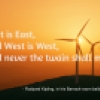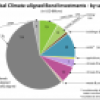Western Wind May Be Where the Twain Shall Meet
In the U.S. West, one unlikely industry, despite politics, is on the verge of aligning opposite parties. It's a fascinating study in contrasts to examine how a new language of wind power economics is evolving and how this could bring opposite forces surrounding climate change to common ground.
Renewable energy-prone coastal state governments like California’s at first seem an odd pairing to fossil fuel-driven ones like Wyoming’s (not to mention interior states west of the Continental Divide). Ten years ago there was one oil man who thought wind energy could be the tie that binds the wild west to Hollywood.
Bill Miller is his name, and he’s president of the Power Company of Wyoming, which is readying to begin building the largest wind farm in the U.S. After years of moseying around governors, legislators, federal and state agency bureaucrats, environmental advocates, public utility honchos and industry analysts, researchers and trade advisors, Miller's become somewhat of a trend reader. From his point of view there’s no stopping renewable energy generated in Wyoming from serving Los Angeles.
Let the Disparities Begin
The irony as this cleantech effort unfolds is an endless display of incongruencies like these: The Staples Center in Los Angeles is owned by the Anschutz Corporation, the same one that controls Miller’s company. The footprint of Los Angeles is about the same size as the Overland Trail Ranch where the wind farm is to be built. Philip Anschutz, chairman and CEO of The Anschutz Corporation, is a former board member of the American Petroleum Institute, an organization that supports climate change disinformation campaigns. But then you have to square how Anschutz Corporation, which grew out of oil and gas, through a series of railroad and telecommunications ventures, wound up throwing its capital heft behind the creation of perhaps the largest wind farm in the world—with a price tag in the vicinity of $8 billion.
To continue the Bizarro World-like metaphor, 1,000 nearly 300-foot-tall wind towers will be hoisted on a 550-square-mile cattle ranch in Carbon County, Wyoming, incredibly linking rural and urban economies located hundreds of miles apart.
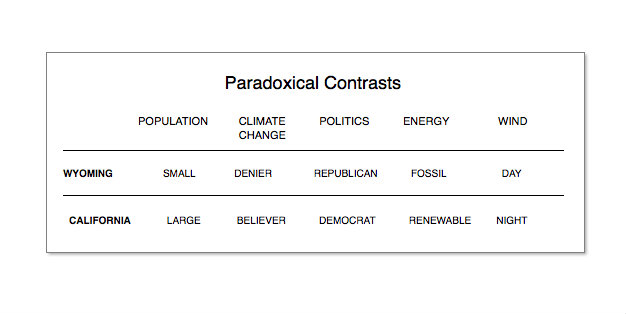
Population Size Matters
The population of California is approaching 40 million, or nearly 67 times greater than the not quite 600,000 people in Wyoming (with less than .02% of California’s). To get a better picture, click on California and Wyoming in EIA’s Energy Mapping System showing population density of U.S. counties from zero to 2,000 people per square mile.
California requires massive amounts of energy. Wyoming has vast amounts of natural resources especially coal and oil, which is exactly what California is trying to cut out of its energy mix. But Wyoming also has ideal areas where high speed onshore winds can be turned into renewable power, but no way to use it.
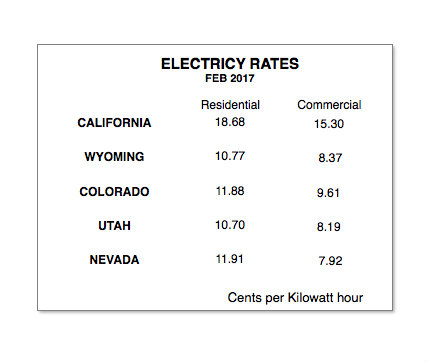
Energy Producers and Distant Users Handshake
The Wyoming economy is driven by and consequently reliant on fossil fuel.
It is the top producer of coal, and ranked second in production of total energy. California produces no coal.
On the flip side, despite its low per capita energy consumption, California’s gargantuan population makes it a top energy consumer. For residential and commercial electricity, Californians already pay significantly higher rates than mountain states.
California utilities' best option is to seek low priced energy not only because of its outsized need, but also because both demand and cost continue to rise. One estimate from Energy + Environmental Economics has estimated somewhere above a 25 percent cost increase in electricity looming beyond the next decade.
Absent in news headlines so not generally on the tips of our tongues is the fact that since the 2008 economic meltdown – and parallel climb in news media prominence of 'cheap' natural gas from fracking – the cost of renewables has been dropping dramatically. Solar power has dropped by over 60 percent, a decrease that is projected to climb to 70% by 2020). See Electric Markets Policy Group report on Berkeley Lab website.
Similarly noteworthy, and also not widely touted to the general public, is that during the last decade wind power in the U.S. has grown to become the second cheapest source of electricity after natural gas according to a December 2016 study from the Energy Institute at the University of Texas at Austin.
It may not be easy to judge the accuracy of analysts estimates, but put in words, Wyoming is the second largest energy producer of all U.S. states and the top producer of coal. California, in contrast, produces no coal and gets nearly one-third of its energy from renewables.
Carbon dioxide emissions illustrate another dichotomy. As the largest state, California understandably ranks number two in CO2 emissions, while Wyoming’s small population means its ranking drops to 30, despite its absolute reliance on fossil fuels. But perhaps a better way to think about the difference is by the fact that Califonia already derives nearly one-third of its electricity from renewables, while currently Wyoming does not require any of its energy sources to be from renewables.
Through yet a third lens, Wyoming ranks number 2 in energy consumption per capita, while California ranks 47. (Source EIA https://www.eia.gov/state/ with interactive state map)
Alien Legislative Agendas
Wyoming’s conservative and California’s progressive governments have uncannily tumbled into the rabbit hole of renewable energy. California mandate requires that 50 percent of its electricity be derived from renewable energy by 2030. Whereas, Wyoming’s protection of fossil fuel and mining industries, instead, led it to recently tax wind power generation $1 per megawatt-hour. No other state does this. In fact, coal-friendly legislators sponsored a bill that would deter state utilities by 2019 from sending either solar or wind power generated electricity to the grid.
At least to Anschutz Corporation, the parent of Power Company of Wyoming, apparently what’s not good for the goose in Wyoming is good for the gander in California. It’s betting their 1,000 turbine wind farm project will generate 10.5 million megawatt hours of electricity annually, not far behind the 12.2 million MWh California produced from its wind farms in 2015, according to a Desert Sun article by Sammy Roth.
California pays some of the steepest prices for energy in the U.S., compared to Wyoming, where energy costs are low. Nevertheless, California’s economic and environmental engines together favor in-state energy generation. Yet the sites in California for capturing the best winds are for the most part maxed out. According to the California Wind Energy Association, the state will probably only be able to develop an additional 2 GW of wind power. It needs to identify another 13 GW from renewable sources to meet the 50% mandate in 2030.
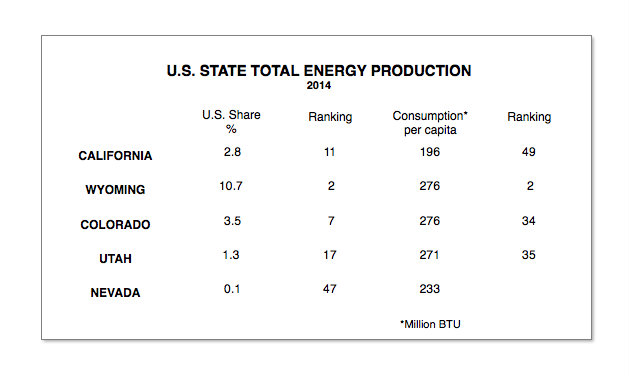
What seems to have changed minds was a government projection that yet-to-be built or completed transmission lines would bring wind-generated electricity from Wyoming and New Mexico at a cost of $21 per megawatt-hour, while pricier in-state wind power today is in the $43 to $58 per MWh range.
The Speed of High Winds
California’s two major wind power regions are Altamonte Pass which you sometimes see when flying east of San Francisco and San Gorgonio Pass, a swath north of Palm Springs, which runs between the San Bernardino Mountains to the north and the San Jacinto Mountains to the south. Near Palm Springs winds average less than 16 miles per hour. Another factor in Wyoming wind’s favor is that California winds blow at night, generating electricity—while demand is lowest.
Wyoming winds peak during the day and can average between 18 and 29 miles per hour. Herein lies the paradox. Energy demand peaks as Californians wake up, go about the day, carry on at night. Peak usage occurs in late afternoons and early evenings which conveniently overlaps the hours when Wyoming wind farms are generating power. Although numerous projects demonstrating technologies for storing unused wind power are taking place in many countries, essentially, utility scale storage technology is is only sporadically and sparingly implemented.
The second hurdle is transmitting Wyoming power along thousands of miles to Los Angeles. However, building transmission lines across multiple states, means patching together private, federal and tribal land. Its potential upside is attracting developers’ attention and warrants a future blog post. The corollary here is that alternate geographies are quite likely to invigorate discontiguous economies and keep the lights on in California, the sixth largest economy on earth. The win for Wyoming, is that a recent economic slowdown due to a growing aversion to coal, would be offset by future purchase arrangements by Wyoming with Utah, Arizona, Nevada and, ultimately, California.
How the Twain Shall Meet
If billionaire Philip Anschutz who has ties to the current administration including newly confirmed Supreme Court Justice Neil Gorsuch, California Democratic Governor Jerry Brown who is a leading proponent of clean technology and defender of climate science and Wyoming Republican Governor Matt Mead who can't politcally afford to defy coal, can successfully overcome their diverse differences to craft cooperative environmental, energy and regulatory strategies that make economic sense, it will teach a lot of lessons and bring benefits to many.
Bringing climate change believers and the not-yet-convinced together in negotiations may cross pollinate a few minds, not to mention avoid tons of toxic emissions. Meanwhile as phase I of the 3,000 MW Chokecherry and Sierra Madre Wind Energy Project gets underway, in one more twist, coal will keep burning and natural gas drillers will keep fracking in Wyoming.



